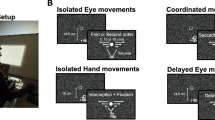Abstract
It has been shown that motion after-effects (MAE) may affect the perceived position of moving objects and, more recently, that MAE signals can also affect pursuit eye movements: smooth pursuit eye movements are favoured by the illusory motion percept that is caused by motion adaptation. Here we investigated the relationship between MAE and arm movements. The objective of our research was: (1) to analyze possible effects of MAE when the arm tracks the changing position of a moving object, and (2) to investigate the influence of MAE on pointing movements to both static and moving targets. Our results show that the (unseen) hand position was trailing the target much less when target and MAE direction was the same. At the end of manual pursuit, subjects caught up with the moving target. However, when target direction was opposite the MAE, subjects’ hands moved more slowly, causing larger lags between the target and the hand position (Experiment 1). In Experiment 2, we found a similar effect of motion signals when subjects pointed to a moving target but found no effect of MAE when pointing to a static object (Experiment 3). We conclude that the effect of motion signals is only revealed when we need to update the changing position of a target.





Similar content being viewed by others
References
Bairstow PJ (1987) Analysis of hand movement to moving targets. Hum Mov Sci 6:205–231
Benjamini Y, Hochberg Y (1995) Controlling the false discovery rate: a practical and powerful approach to multiple testing. J R Stat Soc B 51:289–300
Bertelson P, Boons JP (1960) Time uncertainty and choice reaction time. Nature 187:531–532
Braun DI, Pracejus L, Gegenfurtner KR (2006) Motion aftereffect elicits smooth pursuit eye movements. J Vis 6:671–684
Brenner E, Smeets JB (1997) Fast responses of the human hand to changes in target position. J Motion Behav 29(4):297–310
Bridgeman B, Kirch M, Sperling A (1981) Segregation of cognitive and motor aspects of visual function using induced motion. Percept Psychophys 29:336–342
Engel KC, Anderson JH, Soechting F (2000) Similarity in the response of smooth pursuit and manual tracking to a change in the direction of target motion. J Neurophysiol 84:1149–1156
Gomi H, Abekawa N, Nishida S (2006) Spatiotemporal tuning of rapid interactions between visual-motion analysis and reaching movement. J Neurosci 26:5301–5308
Gregory RL (1966) Eye and Brain. McGraw-Hill, New York
Honda H (1990) The extraretinal signal from the pursuit-eye-movement system: its role in the perceptual and the egocentric localization systems. Percept Psychophys 48:509–515
Linares D, López-Moliner J, Johnston A (2007) Motion signal and the perceived positions of moving objects. J Vis 7(7):1–7
Loftus GR, Masson MEJ (1994) Using confidence intervals in within-subject designs. Psychon Bull Rev 1:476–490
López-Moliner J, Smeets JBJ, Brenner E (2004) Components of motion perception revealed: two different after-effects from a single moving object. Vis Res 44:2545–2549
Maioli C, Falciati L, Gianesini T (2007) Pursuit eye movements involve a covert motor plan for manual tracking. J Neurosci 27:7168–7173
Mitrani L, Dimitrov G (1982) Retinal location and visual localization during pursuit eye movement. Vis Res 22(8):1047–1051
Nakayama K (1985) Biological image motion processing: a review. Vis Res 25:625–660
Nijhawan R (1994) Motion extrapolation in catching. Nature 370:256–257
Nishida S, Johnston A (1999) Influence of motion signals on the perceived position of spatial pattern. Nature 397:610–612
Saijo N, Murakami I, Nishida S, Gomi H (2005) Large-field visual motion directly induces an involuntary rapid manual following response. J Neurosci 25:4941–4951
Schlag J, Schlag-Rey M (2002) Through the eye, slowly: Delays and localization errors in visual system. Nat Rev Neurosci 3:191–200
Smeets JBJ, Brenner E (1995) Perception and action are based on the same visual information: distinction between position and velocity. J Exp Psychol Hum Percept Perform 21:19–31
Smeets JBJ, van den Dobbelsteen JJ, de Grave DDJ, van Beers RJ, Brenner E (2006) Sensory integration does not lead to sensory calibration. Proc Natl Acad Sci 103:18781–18786
Snowden RJ (1998) Shifts in perceived position following adaptation to visual motion. Curr Biol 8:1343–1345
Snowden RJ, Milne AB (1997) Phantom motion aftereffects - evidence of detectors for the analysis of optic flow. Curr Biol 7:717–722
van Beers RJ, Sittig AC, van der Gon JJD (1998) The precision of proprioceptive position sense. Exp Brain Res 122:367–377
van Beers RJ, Wolpert DM, Haggard P (2001) Sensorimotor integration compensates for visual localization errors during smooth pursuit eye movements. J Neurophysiol 85:1914–1922
Watamaniuk SNJ, Heinen SJ (2007) Storage of an oculomotor motion aftereffect. Vis Res 47:466–473
Whitaker D, McGraw PV, Pearson S (1999) Non-veridical size perception of expanding and contracting ob jects. Vis Res 39:2999–3009
Whitney D (2002) The influence of visual motion on perceived position. Trends Cogn Sci 6(5):211–216
Whitney D, Cavanagh P (2000) Motion distorts visual space: shitfting the perceived position of remote stationary objects. Nat Neurosci 3:954–959
Whitney D, Cavanagh P (2003) Motion adaptation shifts apparent position without the motion aftereffect. Percept Psychophys 65:1011–1018
Whitney D, Goodale M (2005) Visual motion due to eye movements helps guide the hand. J Vis 162:394–400
Whitney D, Ellison A, Rice NJ, Arnold D, Goodale M, Walsh V, Milner D (2007) Visually guided reaching depends on motion area MT+. Cereb Cortex 17:2644–2649
Wilmer JB, Nakayama K (2007) Two distinct visual motion mechanisms for smooth pursuit: Evidence form individual differences. Neuron 54:987–1000
Wright MJ (1986) Apparent velocity of motion aftereffects in central and peripheral vision. Perception 15:603–612
Yamagishi N, Anderson SJ, Ashida H (2001) Evidence for dissociation between the perceptual and visuomotor systems in humans. Proc R Soc Lond 268:973–977
Acknowledgments
We would like to thank two anonymous reviewers for their comments and suggestions. This work has been supported by European Science Foundation, Eurocores 06-CNCC-FP-012 grant, and Grant SEJ2006-27544-E from the Spanish Government.
Author information
Authors and Affiliations
Corresponding author
Rights and permissions
About this article
Cite this article
Rodríguez-Herreros, B., López-Moliner, J. The influence of motion signals in hand movements. Exp Brain Res 191, 321–329 (2008). https://doi.org/10.1007/s00221-008-1527-1
Received:
Accepted:
Published:
Issue Date:
DOI: https://doi.org/10.1007/s00221-008-1527-1




